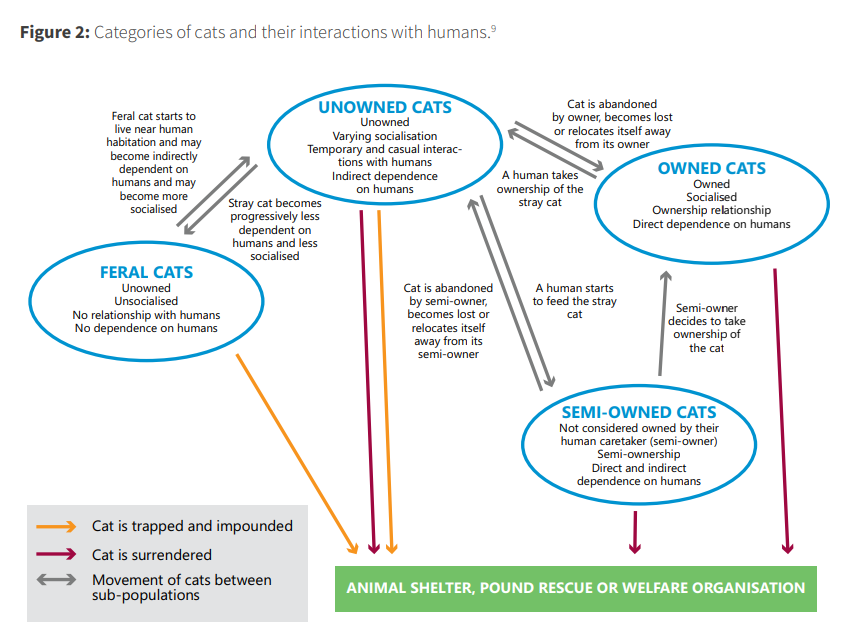|
The Australian Capital Territory (ACT) government has created a detailed action plan to “guide the management of cats—domestic and feral—in the ACT over the next decade” (ACT Cat Plan, pg. 7). The Plan is divided into 8 categories, or “strategies,” that are further divided into various “actions” to be taken by various governments, private organizations, and individuals in order to achieve each strategy. The complexity of the plan, which can be viewed at https://yoursayconversations.act.gov.au/cats-and-dogs/ACT-Cat-Plan, makes it a useful medium for obscuring the reality of its community cat-related strategies, which is that they will be killed, and on an expedited schedule. The authors of the Plan were careful to use compassionate language. The state Vision of the plan, for example, is “All cats in the ACT will be owned, wanted and cared for by responsible owners” (ACT Cat Plan, Pg. 8). That does sound like a wonderful goal, and the strategies and actions listed for the treatment of owned cats and people-friendly stray cats are focused on increasing affordable spay/neuter, promoting adoption, and educating the public about responsible pet ownership. What is not obvious from this vision statement is the implication that outdoor cats will be killed, but the implication is undeniable after scrutinization of the Plan. “Responsible owners” is defined elsewhere in the Plan as those who keep their cats indoors (and it is illegal to allow them to roam freely); this excludes colony caretakers. Since community cats cannot therefore be claimed as owned by their caretakers, nor adopted and brought indoors, they do not fit into the Plan’s Vision for all cats within the ACT. That begs the question, what happens to these outliers? The authors of the Plan do their best to dance around their answer. They make no mention of objectionable buzz words such as culling, eradication, or even euthanasia. However, this is a fragile deception. In fact, all of those practices will be implemented under the Plan. This is evident from a careful reading of Strategy 6, which is “reduce impacts of feral cats” (ACT Cat Plan, pg. 11). One of the actions of this strategy is that the Environment, Planning and Sustainable Development Directorate (EPSDD) will “Support implementation of the Australian Government Threat Abatement Plan for Predation by Feral Cats 2015…” And here are some of the directives/”Actions” of the Threat Abatement Plan:
These lethal methods are immensely cruel. The ACT Cat Plan doesn’t take direct responsibility for these actions, but it is cementing them as part of ACT policy. The fact that it does so discreetly is almost more disturbing than if it had called for the killing of unsocialized cats in a more obvious way. The Plan’s inhumane treatment of community cats is also evident in this Figure printed within its pages. We see from this figure that, under the Plan, all outdoor cats will be brought to shelters. It is a fact that unsocialized cats are euthanatized in shelters where TNR is not practiced because they are not adoptable. This applies to cats that are fearful of people for any reason, whether it be because they are actually wild or simply stressed by their new surroundings and therefore is a death sentence to all unsocialized cats and many unowned and even semi-owned cats.
The ACT Cat Plan takes pains to appear as a document of compassion for cats when in actuality, it is only concerned with the lives of certain cats. Cats that have developed without experiencing human companionship, through no fault of their own, are persecuted by the Plan. While ACR and our members certainly want indoor pet cats to be guaranteed the highest standards of comfort and safety, we care just as much about the wellbeing of community cats. That is why the ACT Cat Plan falls short of being a model for cat and animal welfare, and why we want to be sure ACT citizens read in between its lines. References Australian Government, Australian Capital Territory Government, Environment, Planning and Sustainable Development Directorate. ACT Cat Plan 2021-2031. May 2021. https://hdp-au-prod-app-act-yoursay-files.s3.ap-southeast-2.amazonaws.com/5616/2328/7803/ACT_Cat_Plan_2021-2031_FA_Access.pdf. Accessed 26 Jan 2022. Threat abatement plan for predation by feral cats, Commonwealth of Australia, 2015. https://www.awe.gov.au/sites/default/files/documents/tap-predation-feral-cats-2015.pdf. Accessed 26 Jan 2022.
5 Comments
4/23/2022 01:47:11 pm
Why can’t the rescuers try to get the feral cats onto properties wherein they can be protected, on private property, through fencing, or Catio like environments. Cat sanctuaries, as it were.
Reply
7/21/2023 07:38:48 pm
Shameful. Their sins of omission and weasel words are deeply shocking a they will delude many people into thinking they are doing the right thing.
Reply
Jamie Sommerfeldt
7/21/2023 09:05:15 pm
What, then, is being done to protect the cats?
Reply
Jamie Sommerfeldt
7/21/2023 09:06:58 pm
What is being done to protect these animals?
Reply
7/25/2023 09:28:48 am
Hello, Jamie,
Reply
Leave a Reply. |
Details
AuthorAlley Cat Rescue is leading in the way in promoting humane and compassionate care for ALL cats. Archives
June 2024
Categories
All
|

 RSS Feed
RSS Feed